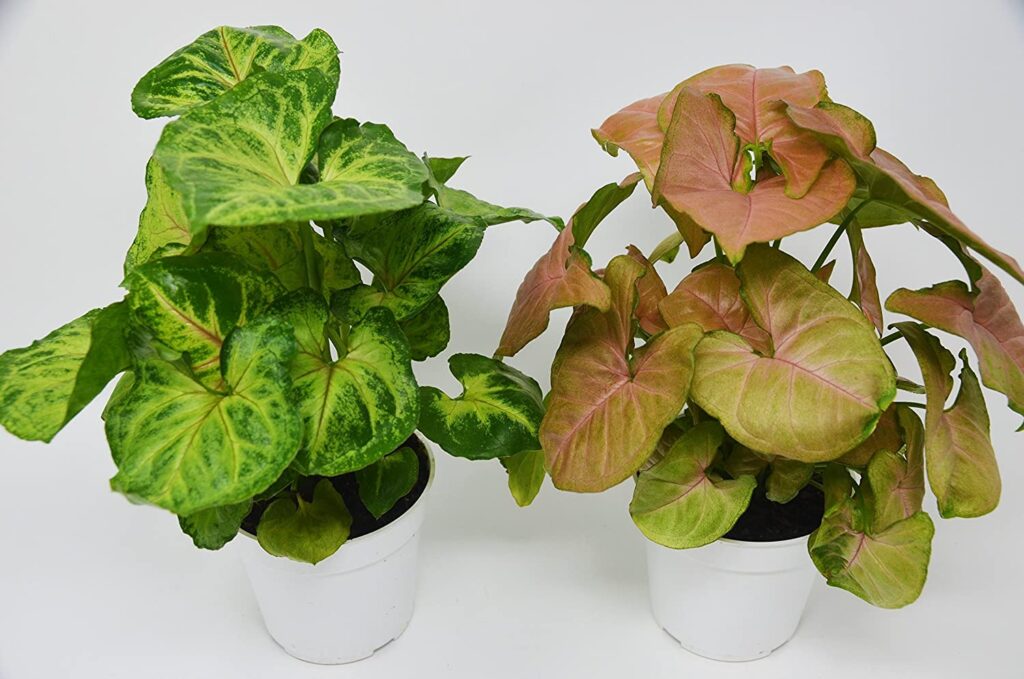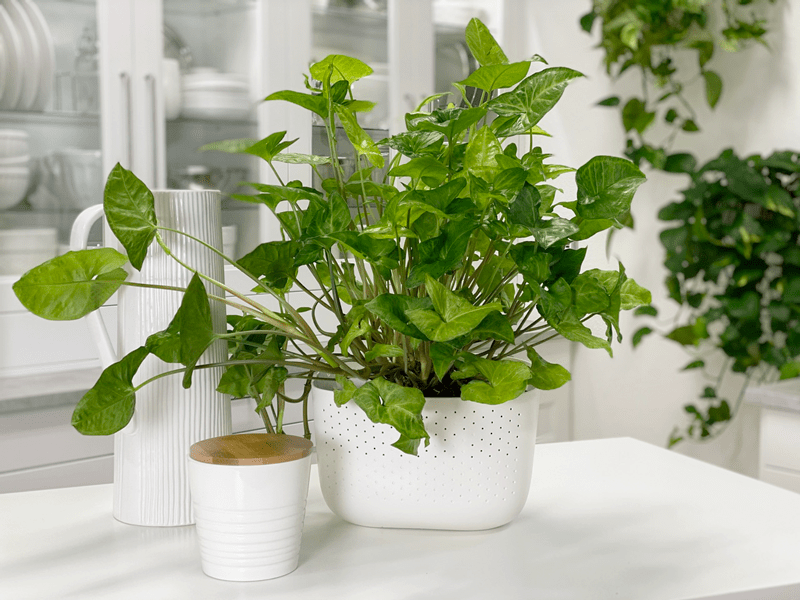An arrowhead plant has the most striking foliage in the houseplant world. These eye-catching leaves happen to be the reason behind the popularity of the houseplant.
But growing an arrowhead plant indoors subjects it to some stresses. These growing conditions’ stresses make the foliage turn yellow at some point.
If you notice the arrowhead leaves turning yellow, do not freak out. The rule of thumb is to investigate the cause and try to fix it.
So, why are my arrowhead leaves turning yellow? It could be due to insufficient water, dim sunlight exposure, overwatering, nutrients deficiency, diseases, and more.
The good news is that you can reverse the yellow leaves to green again. But this is possible when the underlying issue is resolved during the early stages.
There are crucial tricks to consider in making this houseplant stay happy and healthy while growing indoors. Your arrowhead will develop unmatched sculptural and architectural appeal.
This article provides a detailed insight into the causes of arrowhead leaves turning yellow and strategies on how to reverse the condition. Take the time to read through and restore your houseplant.
You May Also Like: Why Are My Arrowhead Plant Leaves Curling?

Causes of Syngonium Leaves Turning Yellow
Common causes of arrowhead leaves turning yellow include:
Improper Sunlight Exposure
Arrowhead plants are quite versatile when it comes to lighting needs. The plant can tolerate different light conditions for a certain period.
The houseplant thrives under bright to moderate lighting. Indoor location is the best environment for growing this African Evergreen plant.
Exposing the plant to direct sunlight will cause scorching and yellowing of leaves. Arrowhead plants can adapt to low light.
But prolonged exposure to low light will make this houseplant develop yellow leaves. Besides that, it will experience stunted growth despite providing the required nutrients.
If you notice your arrowhead leaves turning yellow, consider changing the position of the plant. Place the houseplant near the window to receive bright indirect sunlight to inhibit the leaf problem.
Nutrients Deficiency
Arrowhead plants are moderate feeders. With proper fertilizer application and ultimate care, the houseplant will develop stunning foliage.
Arrowhead leaves turning yellow is a sign of nutrient deficiency. The issue is common in those homes with busy gardeners.
Some of the essential nutrients needed by this plant are nitrogen, magnesium, phosphorus, and more. These nutrients and minerals are common in most artificial fertilizers for houseplants.
The best period to fertilize your houseplant is during the growing season. Spring and summer is the period where gardeners need to fertilize their arrowhead plants monthly.
Avoid fertilizing the plant during fall or winter. It is the period where the plant is dormant and has stopped growing.
I recommend using all-purpose fertilizer for houseplants. Remember to water the plant before applying the fertilizer.
Overwatering Issue
Overwatering is the main cause of arrowhead leaves turning yellow. The arrowhead leaf problem occurs when growing the plant in improper soil moisture.
Research shows that soggy soil and water pool environments are not suitable for growing arrowhead houseplants. It results in the development of a root-rot problem.
Damaged root systems inhibit the intake of nutrients, minerals, and water to support healthy plant growth. Yellowing of leaves is a common sign of a plant with root problems.
The rule of thumb is to inspect the soil before watering the plant. Always insert your index finger in the potting soil to check the moisture level.
If your arrowhead plant is suffering from root rot, consider repotting. It is the best solution to restore the health and well-being of your plant.
Providing proper and consistent soil moisture happens to be the best caring tip for arrowhead plants when growing indoors.
Underwatering Stress
Insufficient water supply to the plant is yet another possible cause of yellow leaves. Arrowhead plants thrive in regions that receive regular water.
The wet growing condition helps the plant develop eye-catching foliage. But remember to avoid overwatering since it can also yellow leaves.
Ensure the growing soil has proper aeration and the pot has drainage holes. It will help to prevent water pool and soil sogginess conditions.
I recommend watering the plant when the soil moisture is about 50%. You can press your index finger in the potting mix to inspect the soil moisture before watering.
Extreme Temperature Changes
The native habitat of arrowhead plants in subtropical and tropical environments. The good news is that the plant can be grown indoors.
Keep in mind that arrowhead plants are very sensitive to temperatures below 50 °F (10°C). It is a growing condition that causes yellowing of leaves and stunted growth.
Besides that, high temperatures can cause sunburn and yellowing of leaves. The best indoor temperature for growing arrowheads ranges from 60°F to 85°F (15°C to 29°C).
Any temperature below or above the minimum requirement will ruin the striking green colors of the foliage. The indoor temperature dynamics can be nerve-wracking when growing houseplants.
Get a digital thermometer to help in measuring the temperature. Keep the houseplant away from any source of heat to avoid scorching the foliage.
You May Also Enjoy: How to Care for Pink Syngonium
Improper Fertilization Techniques
Many gardeners usually stress their arrowhead plants to look appealing without fertilizing them at all. Arrowhead plants boast stunning green foliage making them an excellent indoor plant collection.
These houseplants are not heavy feeders. They require little maintenance to foster eye-catching foliage appeal. This can be achieved through proper fertilization techniques.
Always apply fertilizer to arrowhead plants during the growing season of spring through summer. Winter or fall is the period when the plant is dormant and has stopped growing.
Too much fertilizer will result in the toxic salt buildup. The condition draws water from the roots and this inhibits proper growth. It may also result in the yellowing of leaves.
If you happen to have overfertilized the plant, consider flushing out the soil with plenty of distilled water. You may also consider repotting the plant for a full recovery.
I recommend applying fertilizer monthly during the growing season. Never fertilize your houseplant during fall or winter to prevent the buildup of toxic salt minerals.
Pest Infestations
Arrowhead leaves are highly susceptible to mealybugs and spider mites. These pest infestations can cause the yellowing of leaves.
Spider mites are known for sucking cell sap on the leaves. It drains out the nutrients and moisture from the arrowhead leaves.
The piercing on the leaves and drainage of moisture causes yellowing of leaves. Managing these pest infestations will help to restore your plant.
Use alcohol insecticide sprays and apply to the entire plant. It will help to get rid of these insects damaging your houseplant.
Low Humidity
Arrowhead plants prefer a humid environment similar to their native habitat in South and Central America. High humidity helps to prevent arrowhead leaf problems.
Low humidity will make the arrowhead leaf tips and edges turn brown. Sometimes the arrowhead leaves will start to droop and become yellow on both sides before turning brown.
The best option is to consider misting the leaves about two to three times per week. You can either purchase a humidifier or take the plant to the bathroom.
Old Foliage
Arrowhead plants usually push out new growths during the growing season. If you notice plenty of new growths shooting and yellow leaves underneath, it is pretty normal.
Do not freak since the plant is trying to get rid of the old foliage. The shedding of old foliage helps the plant to send adequate energy and nutrients to new growth.
Yellowing of leaves due to age is inevitable and it occurs to all plants. Remember to investigate the plant further before ruling out anything.
You May Also Like: Why Are My Arrowhead Leaves Turning Brown?

Frequently Asked Questions
Why Is My Syngonium Turning Brown?
The prime cause of arrowhead leaves turning brown is dry air. The best option is to move the houseplant to a different location in case it is near a heating unit or vent. Remember also to mist the leaves to increase the level of humidity.
Why Are My Syngonium Leaves Curling?
Curling leaves is a common arrowhead leaf problem. It is caused by low humidity, improper watering, lack of nutrients, extreme temperatures, overfertilization, and too much light exposure.
Why Is My Arrowhead Plant Drooping?
Arrowhead plants are versatile and can tolerate different growing conditions. But the houseplant is susceptible to drooping due to underwatering and overwatering. Other causes are insufficient lighting, low humidity, temperature stress and fertilizer issues.
Why Are My Arrowhead Plant Leaves Turning Pale?
The most common causes of arrowhead leaves turning pale are low humidity and dry soil. Boost in humidity level will help the houseplant restore the original foliage colors.
Why Are My Syngonium Leaves not Unfurling?
Syngonium plants prefer moderate to bright indirect sunlight. The growing condition allows the plant to stay healthy. Arrowhead leaves not unfurling could be due to root and water problems. Proper watering will help resolve the Syngonium leaves from not unfurling.
Why Are My Nephthytis Leaves Turning Yellow?
Nephthytis and African Evergreen are alternative names to arrowhead plants. Yellowing of leaves could be due to overwatering, low humidity, underwatering, pest infestation, and diseases.
Can You Grow an Arrowhead Plant in Water?
Absolutely. The plant will grow quickly and it will begin to vine. If you are intending to arrowhead for a long time, consider growing in the soil.
Does Arrowhead Plant Have Flowers?
Absolutely. Arrowhead plants usually bloom mid to late summer. It results in white and 3-petalled showy flowers. But there are some species that do not produce flowers at all.
How Big Do Arrowhead Plants Get?
Arrowhead plants have heart-shaped and silvery variegations. The plant grows to about 5 to 14 inches long at maturity.
How Much Light Does an Arrowhead Plant Need?
Arrowhead leaves are highly variegated which require bright indirect sunlight. Too much direct sunlight will cause sunburn. Arrowhead plants can tolerate low light but the leaves will turn yellow at a later stage.
How to Make My Arrowhead Bushy?
Always prune the long vines to maintain 6-8 inches from the soil surface level. Cutting off these long vines helps the plant to become bushy. Remember to pinch off the growing tips every year.
In Conclusion
Arrowhead plants are super easy to maintain. Proper growing conditions help the houseplant to remain healthy and develop green foliage.
But there are instances when the arrowhead leaves will turn yellow due to aging. These old leaves fall off to allow the new leaves to flourish.
Learn how to grow and care for arrowhead plants first. You will identify tricks on how to prevent arrowhead leaves from turning yellow or brown.
You May Also Like: Why Is My African Mask Plant Dying?
More Sources and References
- Gary Moorman. Syngonium Diseases. Penn State Extension.
- Denis McConnell. Production of Syngonium Plants. The University of Florida.
- L. S Osborne. Nephthytis Production Guide. Central Florida Research and Education Center.
